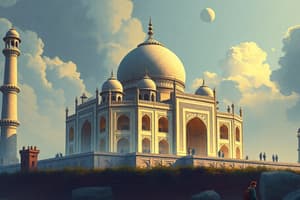Podcast
Questions and Answers
In which state are the Garo, Khasi, and Jaintia hills located?
In which state are the Garo, Khasi, and Jaintia hills located?
- Himachal Pradesh
- Meghalaya (correct)
- Punjab
- Assam
Which plateau lies between the Aravalli and the Vindhya range?
Which plateau lies between the Aravalli and the Vindhya range?
- Deccan Plateau
- Chota Nagpur Plateau
- Malwa Plateau (correct)
- Peninsular Plateau
The river Narmada has its source at which location?
The river Narmada has its source at which location?
- Amarkantak (correct)
- Bramhagiri
- Satpura
- Slopes of Western Ghats
Yamuna, Ghaghra, and Kosi are important tributaries of which river?
Yamuna, Ghaghra, and Kosi are important tributaries of which river?
India lies in the region of which winds?
India lies in the region of which winds?
Which is considered the coldest place in India?
Which is considered the coldest place in India?
What is a liability for the economy?
What is a liability for the economy?
What is the purpose of implementing the mid-day meal?
What is the purpose of implementing the mid-day meal?
What is the relationship between latitude and air temperature?
What is the relationship between latitude and air temperature?
Which control of climate is primarily influenced by the Earth's curvature?
Which control of climate is primarily influenced by the Earth's curvature?
How does altitude affect temperature?
How does altitude affect temperature?
What phenomenon is described by the term 'continentality'?
What phenomenon is described by the term 'continentality'?
Which factor influences the rainfall pattern of an area the least?
Which factor influences the rainfall pattern of an area the least?
How do relief features affect the climate of an area?
How do relief features affect the climate of an area?
Which statement accurately describes the influence of ocean currents on coastal climates?
Which statement accurately describes the influence of ocean currents on coastal climates?
Which of the following is NOT one of the six major controls of climate?
Which of the following is NOT one of the six major controls of climate?
Flashcards are hidden until you start studying
Study Notes
Geography of India
- Garo, Khasi, and Jaintia hills are located in Meghalaya.
- The Malwa Plateau lies between the Aravalli and Vindhya ranges.
- The Narmada River sources from Amarkantak.
- Yamuna, Ghaghra, and Kosi are important tributaries of the Ganga.
- India experiences northeasterly winds.
Climate & Weather
- Drass is considered the coldest place in India.
- Illiterate individuals can be a liability for the economy.
- Mid-day meal implementation aims to encourage attendance and retention of children.
- Poverty lines are estimated nearly every four years.
- NSSO stands for National Sample Survey Organization.
Environmental Features
- Differences between the two island groups of India include geographical location and ecological conditions.
- The two headstreams of the Ganga are the Bhagirathi and Alaknanda, which meet at Devprayag.
- Western Ghats receive more rainfall than Eastern Ghats due to their geographical positioning and topography.
- Disguised unemployment occurs when individuals appear employed but do not contribute effectively, such as farmers working on over-populated lands.
Employment & Economy
- Seasonal employment patterns vary, with demand peaking in agricultural peak seasons.
- Vulnerable social groups to poverty include marginalized communities and uneducated individuals.
- Climate factors affecting India include latitude, altitude, distance from the sea, and wind systems.
- Mawsynram, located in Meghalaya, receives the highest amount of rainfall due to monsoons and orographic lift.
Water Resources
- Man-made lakes are created through dam construction and are often used for irrigation, drinking water, and hydroelectric power; an example is the Hirakud Dam.
- Coastal plains along the Arabian Sea include the Konkan coast, characterized by beaches, high population density, and rich cultural heritage.
Rivers of India
- Himalayan rivers, such as the Ganga and Yamuna, are fast-flowing, perennial, and have a larger volume compared to Peninsular rivers like the Godavari and Krishna, which are seasonal and meandering.
- Water divides mark the boundaries between different river basins, affecting the flow patterns.
Socio-Economic Issues
- Increasing unemployment adversely affects economic growth by reducing consumer spending and overall productivity.
- The workforce population refers to individuals aged 15-64, essential for economic activities in agriculture and other sectors.
- Social exclusion is a dual cause and consequence of poverty, creating a cycle of disadvantage for certain groups.
Climate Determinants
- Earth's curvature affects climate by altering solar energy distribution, with temperature decreasing from the equator to the poles.
- Temperature decreases with altitude due to less dense atmospheric layers; thus, higher altitudes experience cooler temperatures.
- Coastal areas experience moderating climate effects due to the proximity to the sea, but distances may lead to extreme weather conditions, known as continentality.
- Ocean currents significantly influence coastal climates by warming or cooling based on prevailing onshore winds.
Geographic Influence
- Relief features, such as high mountains, impact climate by acting as barriers to winds and promoting precipitation on windward slopes while leeward areas remain dry.
Studying That Suits You
Use AI to generate personalized quizzes and flashcards to suit your learning preferences.




